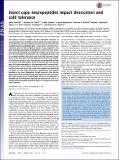Files in this item
Insect capa neuropeptides impact desiccation and cold tolerance
Item metadata
| dc.contributor.author | Terhzaz, Selim | |
| dc.contributor.author | Teets, Nichholas M. | |
| dc.contributor.author | Cabrero, Pablo | |
| dc.contributor.author | Henderson, Louise | |
| dc.contributor.author | Ritchie, Michael G. | |
| dc.contributor.author | Nachman, Ronald J. | |
| dc.contributor.author | Dow, Julian A. T. | |
| dc.contributor.author | Denlinger, David L. | |
| dc.contributor.author | Davies, Shireen-A. | |
| dc.date.accessioned | 2015-03-27T10:01:03Z | |
| dc.date.available | 2015-03-27T10:01:03Z | |
| dc.date.issued | 2015-03-03 | |
| dc.identifier | 176906238 | |
| dc.identifier | 94298b4d-2d05-47fe-a9c4-73a70d6aedce | |
| dc.identifier | 84924405432 | |
| dc.identifier | 000350224900070 | |
| dc.identifier | 25730885 | |
| dc.identifier.citation | Terhzaz , S , Teets , N M , Cabrero , P , Henderson , L , Ritchie , M G , Nachman , R J , Dow , J A T , Denlinger , D L & Davies , S-A 2015 , ' Insect capa neuropeptides impact desiccation and cold tolerance ' , Proceedings of the National Academy of Sciences of the United States of America , vol. 112 , no. 9 , pp. 2882-2887 . https://doi.org/10.1073/pnas.1501518112 | en |
| dc.identifier.issn | 0027-8424 | |
| dc.identifier.other | ORCID: /0000-0001-7913-8675/work/46761145 | |
| dc.identifier.uri | https://hdl.handle.net/10023/6375 | |
| dc.description | This work was funded by grants from the UK Biotechnology and Biological Sciences Research Council (BB/G020620 and BB/L002647/1) (to S.-A.D., J.A.T.D., and S.T.); US Department of Agriculture/Department of Defense Deployed War Fighters Protection Grant Initiative (#6202-22000-029-00D) and US–Israel Binational Agricultural Research and Development Fund (BARD) (IS-4205-09C) (R.J.N.); and the National Science Foundation (IOS-0840772) (D.L.D.). | en |
| dc.description.abstract | The success of insects is linked to their impressive tolerance to environmental stress, but little is known about how such responses are mediated by the neuroendocrine system. Here we show that the capability (capa) neuropeptide gene is a desiccation- and cold stress-responsive gene in diverse dipteran species. Using targeted in vivo gene silencing, physiological manipulations, stress-tolerance assays, and rationally designed neuropeptide analogs, we demonstrate that the Drosophila melanogaster capa neuropeptide gene and its encoded peptides alter desiccation and cold tolerance. Knockdown of the capa gene increases desiccation tolerance but lengthens chill coma recovery time, and injection of capa peptide analogs can reverse both phenotypes. Immunohistochemical staining suggests that capa accumulates in the capa-expressing Va neurons during desiccation and nonlethal cold stress but is not released until recovery from each stress. Our results also suggest that regulation of cellular ion and water homeostasis mediated by capa peptide signaling in the insect Malpighian (renal) tubules is a key physiological mechanism during recovery from desiccation and cold stress. This work augments our understanding of how stress tolerance is mediated by neuroendocrine signaling and illustrates the use of rationally designed peptide analogs as agents for disrupting protective stress tolerance. | |
| dc.format.extent | 6 | |
| dc.format.extent | 1114844 | |
| dc.language.iso | eng | |
| dc.relation.ispartof | Proceedings of the National Academy of Sciences of the United States of America | en |
| dc.subject | Environmental stress | en |
| dc.subject | Insects | en |
| dc.subject | Neuropeptides | en |
| dc.subject | Capa | en |
| dc.subject | Desiccation and cold tolerance | en |
| dc.subject | QH301 Biology | en |
| dc.subject | NDAS | en |
| dc.subject | BDC | en |
| dc.subject | R2C | en |
| dc.subject.lcc | QH301 | en |
| dc.title | Insect capa neuropeptides impact desiccation and cold tolerance | en |
| dc.type | Journal article | en |
| dc.contributor.institution | University of St Andrews. Centre for Biological Diversity | en |
| dc.contributor.institution | University of St Andrews. Institute of Behavioural and Neural Sciences | en |
| dc.contributor.institution | University of St Andrews. School of Biology | en |
| dc.identifier.doi | https://doi.org/10.1073/pnas.1501518112 | |
| dc.description.status | Peer reviewed | en |
| dc.identifier.url | https://www.pnas.org/content/suppl/2015/02/12/1501518112.DCSupplemental | en |
This item appears in the following Collection(s)
Items in the St Andrews Research Repository are protected by copyright, with all rights reserved, unless otherwise indicated.

